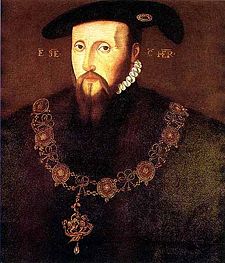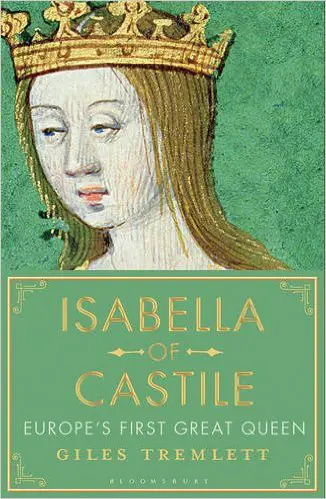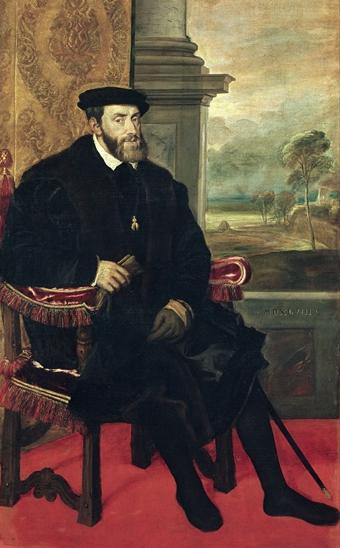 On this day in history, Tuesday 1st February 1547, the executors of Henry VIII's will appointed Edward Seymour, Earl of Hertford, to the offices of Lord Protector of the Realm and Governor of the King's Person.
On this day in history, Tuesday 1st February 1547, the executors of Henry VIII's will appointed Edward Seymour, Earl of Hertford, to the offices of Lord Protector of the Realm and Governor of the King's Person.
Here is the record from Acts of the Privy Council:
The furste day of February, being Twesday, all the saide executours before written assembled againe togwither in the saide Towre of Lundon and there according to their former appoinctement herde the wille eftesones deliberately redde from the begynning to thending, and concluding with oone voice to adhere and stycke to the perfourmance of it, did furste take their othes to the Kinges Majestie, our Souvaigne Lorde, and after ymmediately sware to the due and faithfull observacion of the saide wille as the day before they had resolved. And forasmuche as this daye all the Lordes Spiritual and Temporal and all others appointed by the Kinges Majestie our late Souveraigne Lord (whome God absolve) to be of Consaill with our Souveraigne Lorde that nowe is, for thaide and assistence of thexecutours and Privey Counsaillours in all cases wherein the same shuld have neade of advise and counsail, were apoincted to have their accesse to the Kinges Majestes presence, it was also ordred that the hole nombre of executours present shuld repaire to the Kinges Majeste and declare to him what they had doone towching the naming and placing of the saide Earle of Hertforde, his uncle, to be Protectour of his realmes and dominions and Gouvernor of his persone, and to require his consent to the same; and that doone that we shuld declare the same furste to the Counsail nat being executours, and after to all the Lordes on the presence of the Kings Majeste, which was doon in every poincte as was determyned. And furste the Kinges Majeste by thadvise and consent of all the saide executours being present with him gave his royal assent that the said Earle of Hertforde shuld be Protectour of his realmes and domynions and Governor of his persone, next it was declared to the Counsail, and thirdly to all the Lordes, being the same declared unto them by the saide Lorde Chauncellor, who with oone voyce gave their consentes to the same.
The imperial ambassador, François van der Delft, wrote of the rise of Hertford in a report dated 10th February:
It is to be borne in mind, in the first place, that amongst these men there are four, who, according to present appearances, will take into their hands the entire direction of affairs. These are the earl of Hertford, the Lord Chancellor, the Lord Admiral and Paget. Each one of these will strive his best for his own advancement, and it is already evident that this is the case by the action of the earl of Hertford himself. He was simply appointed first of the Councillors by the testament of the late King, but he at once made himself the head of them all, and has assumed the title of Protector of the present King Edward and of his realm."
Van der Delft went on to say that Hertford "causes to be borne before him two gilt maces" and that he intended to make his brother, Thomas Seymour, Lord Admiral, and that John Dudley, the present Lord Admiral, "aspires to be Lord Chamberlain and Commander in Chief". He concluded that "It thus seems probable that the earl of Hertford and the Lord Admiral (Dudley) will enjoy the honours and titles of rulers of the realm, whilst the Lord Chancellor and Paget will in reality have the entire management of affairs."
Van der Delft also commented on the rivalry between Hertford and Dudley: "It is, of course, quite likely that some jealousy or rivalry may arise between the earl of Hertford and the Lord Admiral, because, although they both belong to the same sect they are nevertheless widely different in character: the Lord Admiral being of high courage will not willingly submit to his colleague. He is, moreover, in higher favour both with the people and with the nobles than the earl of Hertford, owing to his liberality and splendour. The Protector, on the other hand, is not so accomplished in this respect, and is indeed looked down upon by everybody as a dry, sour, opinionated man."
Henry VIII had never meant for one man, or even four men, to take control. His will - members can click here to read it - stipulated that while his son was under the age of eighteen that he was to be "ruled as regards marriage and all affairs by the aforesaid Councillors", sixteen men he named in his will as executors who were to form a regency council, along with twelve other advisers. Henry VIII also instructed that "none of them shall do anything appointed by this Will alone, but only with the written consent of the majority". The plan was that the council would rule collectively with every member having equal power and rights. However, the will also allowed the executors to grant themselves lands and honours, so Edward Seymour took advantage of this and made himself Duke of Somerset and Lord Protector of his nephew’s council, with the agreement of 13 out of the 16 executors. Seymour then went on to rule by proclamation, making all of the decisions himself.
Of course, Edward Seymour was to fall from grace in late 1549. He was arrested on 11th October 1549 and brought in front of Edward VI who summarised his charges as "ambition, vainglory, entering into rash wars in mine youth, negligent looking on Newhaven, enriching himself of my treasure, following his own opinion, and doing all by his own authority, etc." Edward Seymour's downfall was the result of widespread social unrest in England, such as the Prayer Book Rebellion in the South West in 1549, something which the rest of the council blamed him for. After his arrest, Somerset was succeeded as the leader of Edward VI's council by John Dudley, the Earl of Warwick, and although he was later released and restored to a place on the council, he was eventually executed on the 22nd January 1552 after plotting to overthrow Dudley. John Dudley led Edward VI's government as Lord President of the Council, rather than Lord Protector, until Edward's death in July 1553.
Notes and Sources
- 'Pages 7-8', in Acts of the Privy Council of England Volume 2, 1547-1550, ed. John Roche Dasent (London, 1890), pp. 1-25. British History Online http://www.british-history.ac.uk/acts-privy-council/vol2/pp1-25 [accessed 22 January 2017].
- 'Spain: February 1547, 1-10', in Calendar of State Papers, Spain, Volume 9, 1547-1549, ed. Martin A S Hume and Royall Tyler (London, 1912), pp. 14-21, 10 Feb Van der Delft to the Queen Dowager. British History Online http://www.british-history.ac.uk/cal-state-papers/spain/vol9/pp14-21 [accessed 27 January 2017].
- "The Arrest of Edward Seymour, Duke of Somerset and Lord Protector" by Claire Ridgway, http://www.elizabethfiles.com/the-arrest-of-edward-seymour-duke-of-somerset-and-lord-protector/4365/



Leave a Reply